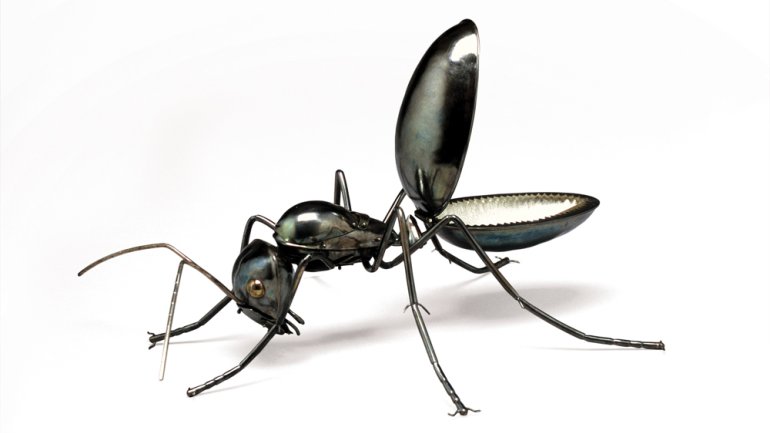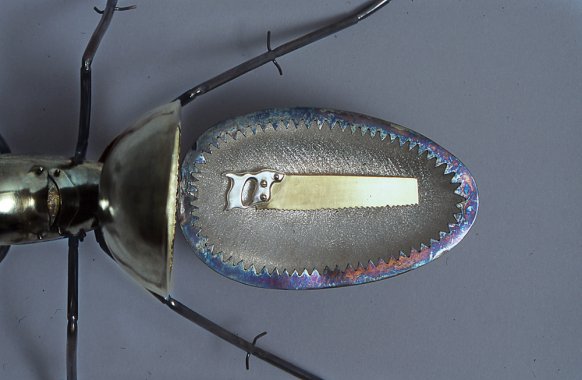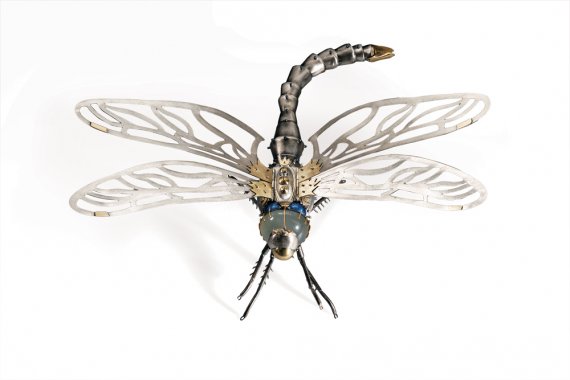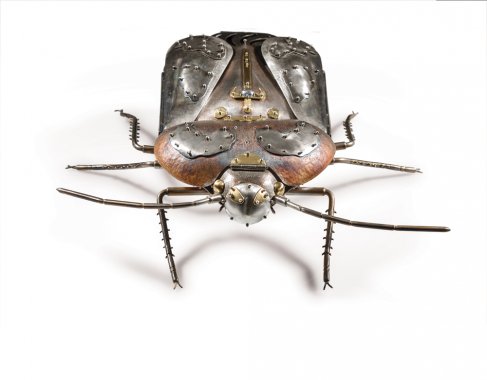Sorry to Bug You
Sorry to Bug You
Bugs give many people the creeps. The skittering legs, the small bodies suited to sneaking in windows and lurking in corners, the periscope eyes and pincer jaws prompt entomophobes to stomp on them on sight.
But for Elizabeth Goluch, the tiny creatures are a source not of fear but of wonder, of the mystery that hides in the small spaces of the world.
Goluch, a Nova Scotia metalsmith, specializes in replicating the insect world in exacting yet fantastical sculptures. But her larger-than-life creatures have exoskeletons in hard metal, much sturdier armor against a panicked human.
Her passion for bugs began in childhood. She grew up on a farm in Ontario, “and in those days you weren’t supervised constantly; you got to do things to entertain yourself. Because I was close to the ground, I just looked at everything, and I noticed all the insects and found them, really, quite interesting.” Her fascination quickly found artistic expression. Goluch recalls her first drawing as “a page of spiders, just multiple spiders. I just kept drawing them.”
As an undergraduate at the Nova Scotia College of Art and Design in the 1970s, Goluch studied painting, though by the time she graduated she had become interested in three-dimensional work. She deferred that interest for a while, as she went back to Ontario, got married, and turned her attention to raising her two children. As they grew up, she returned to her art – and to NSCAD, where she took night courses in basic jewelry techniques in the mid-1990s. When it came time to try her hand at a piece, Goluch knew what she wanted to make: a praying mantis “the size of a small cat,” built with scrap metal in the NSCAD studio.
“It wasn’t very well crafted,” she laughs, but it set in motion the work that would define her career. She continued learning through the Metal Arts Guild of Nova Scotia. “I think it was by about 1997 that I actually made the first pieces that were acceptable, in my opinion,” she says.
The pieces she has produced over the past two decades are marvels of concept and design, imagination and technique. They show their maker’s extensive knowledge of insect anatomy – to make accurate wings, feet, and mandibles, Goluch turns to reference books and the internet for close-up images – and contain secret compartments or hidden symbols suggesting the oft-overlooked work insects do.
Carpenter Ants (Work Is Play) (2005) is a grouping of three members of this common species, in sterling silver and gold. Goluch expands their scale, stretching them to 9 and 10 inches long, and, with careful soldering and riveting, renders visible otherwise indiscernible details. You can see the tiny claws at the tips of their legs, the elegant swoop of antennae. In each of their bulbous abdomens Goluch hides a builder’s tool – a sly testament to the ants’ daily activity.
Goluch counts Insect Dreams. A Firefly’s Tale (2017) among her more difficult and rewarding projects. A miniature picture book composed of thin silver pages, it traces a firefly’s life cycle and captures its ambient beauty. Material led to innovation, as it often does for Goluch; to create the illusion of light, she blackened the surfaces through oxidization, then scrubbed away some of the darkness around the bugs’ incandescent tails.
Goluch says she never set out to be an ambassador for an underappreciated segment of the animal kingdom, but she notes that her work sometimes can make skeptics a little more open to the idea of a beautiful bug. Her materials – the gold, silver, enamel, and gemstones – naturally attract attention. “That’s kind of the gateway through the fear factor that they have, to seeing the insect as a beautiful creature, rather than a scary, horrible part of nature.”





